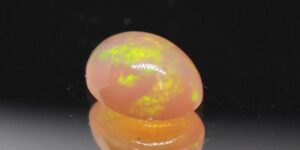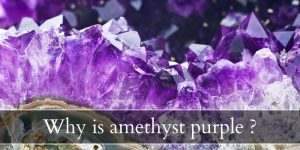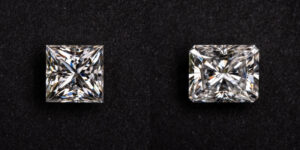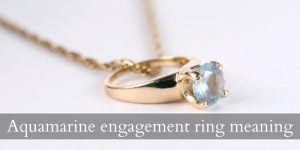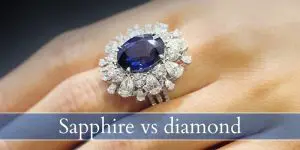Wondering what brilliance and fire mean in a diamond ? They’re very pretty words for the result of some really complex optical and physical factors at work. A diamond (and a moissanite) is a prism, it bends the light and splits it and in the end reflects it back to your eyes. We’ll explain what brilliance is, what fire is, how they work together, and the factors that directly affect them. This will get a little technical, so bear with us.
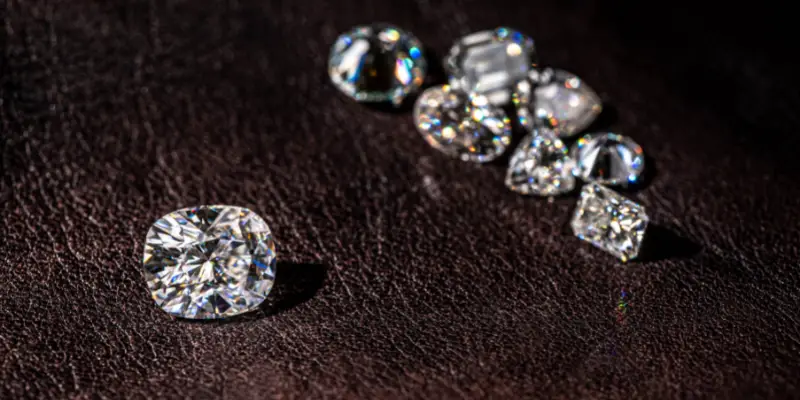
What is brilliance in a diamond ?
Brilliance is the white light that a diamond sends back into your eyes. A diamond, when faceted and polished, acts like a prism, where white light enters, then splits into the rainbow, and then some of the light is brought back through the top (crown and table) as white light, and some of it remains rainbow-colored. The white light you see coming back out of the diamond is the brilliance of the diamond.
A very well cut diamond will give you a balanced brilliance and fire output.
What is fire in a diamond ?
Fire in a diamond is the colorful sparkles you see, the rainbow-colored sparkle that results when white light is split into its components. The diamond is a prism and it splits white light, and some of the light exits as fire (rainbow) and some it exits as brilliance (white).
Most diamonds will show equal parts fire and brilliance, and this is one of the key ways to tell a diamond from a moissanite: the moissanite will have more fire than brilliance when compared to a diamond of the same size and cut.
What is scintillation ?
Scintillation in a diamond is the interplay between fire and brilliance, the way they interact and follow one another. A good diamond will have good scintillation, and show you equal parts brilliance and fire. A diamond cut too deep will not have much scintillation, and may show you mostly fire. Meanwhile a diamond cut too shallow will show you mostly brilliance.
Key factors affecting fire and brilliance in a diamond
There are several factors affecting why you see more fire or more brilliance, and why some diamonds just don’t sparkle as much as others. A diamond is a prism, it splits light, and we first need to look at the two most important factors that determine fire and brilliance: refractive index and dispersion.
The refractive index bends the light within a prism (diamond)
A diamond’s refractive index is the degree to which it can bend the light when it enters the diamond. All transparent materials have a refractive index, and diamond’s index is 2.42, while moissanite’s index is 2.69. The greater the index, the greater the bend and thus the trajectory of the light beams within the prism.
When the light first enters a diamond, it does not go straight through, it goes through bent at a slight angle. Each time the light hits another facet within the diamond or moissanite, it’s reflected at that angle, so overall a diamond and a moissanite work light a little differently. Different enough to get more rainbow color than white light, especially when paired with each material’s dispersion and the way the facets are arranged.
Read also: Diamond Cut VS Color
Diamond dispersion splits the light
Dispersion is the act of white light separating into its component (rainbow) colors: red, orange, yellow, green, blue, indigo, violet. All of these colors brought together form white light, and if you split white light through a prism, you get the rainbow. Think of Pink Floyd’s Dark Side of the Moon album cover art.
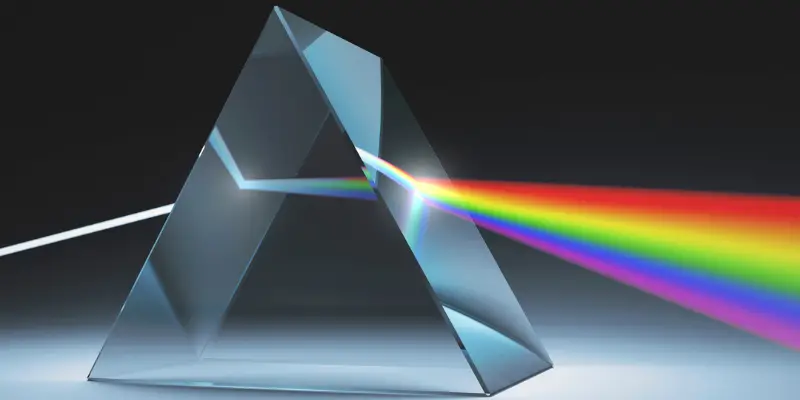
A prism (in this case a diamond) splits incoming white light into rainbow light, and the only way to get the white light back is to run the rainbow through a prism again, and ‘tie’ back together all the 7 colors, creating white. A diamond is a prism, and a very complex one at that, hence white light splitting but showing equal parts white and rainbow. Some of those rainbow color beams manage to get back together as white light, and some stay separate and show up as colors.
Dispersion happens in any material, in some it’s less pronounced and in some it’s more. The greater the dispersion in a material, the more fire you will see, and less brilliance. Such is the case with diamond and moissanite.
Why does moissanite have more fire than diamond ?
There are several factors that create more fire, and the two most important are the material’s refractive index, and the dispersion. Since moissanite has a refractive index of 2.69, diamond has 2.42 and this bends the light enough to bring out more rainbow fire than white light, when the gemstones have the exact same cut.
Not only that, but moissanite has higher dispersion than a diamond. To be specific moissanite’s dispersion is 0.104 while diamond’s dispersion is 0.044, so half the dispersion in a moissanite. How does this impact fire and sparkle ? The greater the dispersion in a material (in this case moissanite and diamond), the more rainbow color your eye will perceive.
Remember, dispersion is white light splitting into its rainbow components. In short, a higher dispersion is a ‘wider’ space between the rainbow colors, so less chance of them bouncing around the prism and eventually getting back together as white light.
Can you tone down fire in a moissanite or diamond ?
Yes, you can make the fire less apparent and bring in more brilliance by adding more facets and making them smaller. This is what a crushed ice cut does. It adds another set of facets on the pavilion which break up the sparkles into smaller ones, reducing the size of fire and adding more brilliance. This works best for moissanites because it balances the rainbow with the white light.
For diamonds a crushed ice cut will work differently, due to the different dispersion and refractive index. A crushed ice cut in a diamond will bring more brilliance than fire, and the diamond’s body color will be much easier to notice. This isn’t great if you’re trying to hide a yellow tint, but if you’ve got a fancy color diamond and want to emphasize the color then a crushed ice cut is just what you need.
Read also: What Makes Diamonds Sparkle ?
Secondary factors affecting fire and brilliance in a diamond
Now that we understand the way light bends through a diamond or moissanite, we also need to look at the structures themselves. After all, the light’s path is directly influenced by the structure’s shape and the facets and the angles present. So here are the two secondary factors that affect fire and brilliance, relating directly to the shape of the prism (diamond or moissanite).
Depth of cut directly affects fire and brilliance
Depth of cut is the total depth from the table to the culet and it directly affects the way the light bounces within a diamond. A shallow diamond will white out, revealing mostly brilliance and very little to no fire. A deep cut diamond will look dull and occasionally show fire. This was one of the issues with old European and old mine cuts. They were deep cuts, with larger facets than modern diamonds, and were mainly focused on showing fire.
Brilliance or brightness within the diamond weren’t as important at the time, since the light sources were different when these cut styles were invented and became popular. Candle light was most prominent at the time, especially for old mine cuts, and candle light tends to work better for deeper cut gemstones.
The number and size of facets affects brilliance and fire
The number of facets and their size directly affect the sparkle and light in a diamond. For example step cuts have fewer facets, and are larger. They don’t sparkle like brilliant cuts because the facets are fewer and larger. Instead the light comes out as wide flashes of rainbow color, and a bit of brilliance.
When the facets are smaller but more of them, like in a brilliant cut, the fire and brilliance are mostly balanced, and you get the classic look found in a round brilliant cut.
And, when the facets are smaller still and even more of them, like in a crushed ice type of cut, the fire gets cut into smaller pieces and brilliance shows up more.
Why does this happen ? The larger the facet, the larger the physical space for the fire (rainbow) to show all its colors. So a smaller facet will only show 2-3 colors out of 7, and the tiny crushed ice facets will typically only have room to show 1. The fire is still there, you just can’t see all of it because there is not enough room on each facet. Meanwhile brilliance only shows 1 color (white) so it will show up regardless of the facet size.

I’m the main author for jewelrymaterialguide.com. I started this site after we did tons of research before our wedding and noticed that there is information about rings, jewelry, and so on that is really hard to find on the internet.

